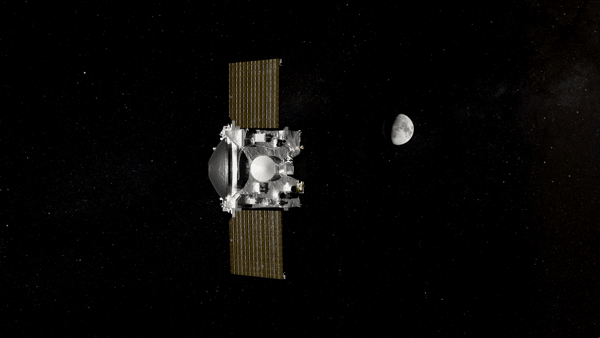NASA's OSIRIS-REx spacecraft releases asteroid sample capsule toward Earth in flyby, heads to Apophis
OSIRIS-REx's samples of asteroid Bennu will land at 10:55 a.m. EDT (1455 GMT), while the spacecraft itself heads to a new target.
Update for 11 a.m. EDT: NASA's OSIRIS-REx sample return capsule successfully landed with samples of asteroid Bennu at 10:52 a.m. EDT (8:52 a.m. MDT/1452 GMT) in the Utah desert as recovery teams watched. You can watch its recovery live on Space.com. It is also in the window above.
The first asteroid samples ever collected by NASA are closing in on Earth for a historic landing in the Utah desert today (Sept. 24).
NASA's OSIRIS-REx spacecraft, which collected samples of asteroid Bennu in 2020, released a capsule carrying that precious cargo at 6:42 a.m. EDT (1042 GMT) on a course to land on Earth. The spacecraft was 63,000 miles (101,388 kilometers) from Earth, about one-third the distance to the moon, when it released the sample capsule, with OSIRIS-REx itself flying past our planet to a new destination, NASA officials said.
"After traveling for about four hours through space, the capsule will enter the atmosphere off the coast of California at about 10:42 a.m. EDT (8:42 a.m. MDT) and head east," NASA wrote in an update. "It will land about 13 minutes later in a predetermined 36-mile by 8.5-mile area on the Department of Defense's Utah Test and Training Range near Salt Lake City." You can watch that landing live on Space.com, courtesy of NASA TV, beginning at 10 a.m. EDT (1400 GMT).
Live updates: OSIRIS-REx asteroid sample return landing
Related: How to bring asteroid samples to Earth in 5 not-so-easy steps

The $1 billion OSIRIS-REx mission, its name is short for Origins, Spectral Interpretation, Resource Identification, Security-Regolith Explorer, launched in 2016 to visit and collect samples of the near-Earth asteroid Bennu, which itself will fly close by Earth in 2182. The mission is aimed at better understanding the composition of the 1,650-foot-wide (500 meters) Bennu and asteroids like it, remnants from the early solar system.
So far, OSIRIS-REx's sample return preparations have gone smoothly, with the sample capsule on course to reenter Earth's atmosphere just off the California coast, streaking across the morning sky and parachute to the ground at its Utah drop zone. The OSIRIS-REx spacecraft itself, its job complete, is now leaving Earth behind.
At about 7 a.m. EDT (1100 GMT), OSIRIS-REx successfully fired its engines in what NASA calls a diversion burn so it does not fall to Earth like its sample capsule. The spacecraft is headed to a new target, the asteroid Apophis, which will also fly close to Earth in 2029. NASA officially renamed the mission OSIRIS-REx-APEX to note the change.
Get the Space.com Newsletter
Breaking space news, the latest updates on rocket launches, skywatching events and more!
"Roughly 1,000 feet wide, Apophis will come within 20,000 miles of Earth – less than one-tenth the distance between Earth and the Moon – in 2029.
NASA wrote in a separate update. "OSIRIS-APEX is scheduled to enter orbit of Apophis soon after the asteroid’s close approach of Earth to see how the encounter affected the asteroid’s orbit, spin rate, and surface."
Join our Space Forums to keep talking space on the latest missions, night sky and more! And if you have a news tip, correction or comment, let us know at: community@space.com.

Tariq is the Editor-in-Chief of Space.com and joined the team in 2001, first as an intern and staff writer, and later as an editor. He covers human spaceflight, exploration and space science, as well as skywatching and entertainment. He became Space.com's Managing Editor in 2009 and Editor-in-Chief in 2019. Before joining Space.com, Tariq was a staff reporter for The Los Angeles Times covering education and city beats in La Habra, Fullerton and Huntington Beach. In October 2022, Tariq received the Harry Kolcum Award for excellence in space reporting from the National Space Club Florida Committee. He is also an Eagle Scout (yes, he has the Space Exploration merit badge) and went to Space Camp four times as a kid and a fifth time as an adult. He has journalism degrees from the University of Southern California and New York University. You can find Tariq at Space.com and as the co-host to the This Week In Space podcast with space historian Rod Pyle on the TWiT network. To see his latest project, you can follow Tariq on Twitter @tariqjmalik.









